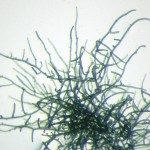Link to Pubmed [PMID] – 27009717
Link to DOI – 10.1111/j.1529-8817.2012.01118.x
J Phycol 2012 Apr; 48(2): 275-84
Marine benthic cyanobacteria in tropical areas have recently been associated with several human poisoning events. To enhance the characterization of these microorganisms and their potential toxicity, benthic cyanobacterial communities were sampled in the lagoons of two islands (Raivavae and Rurutu) located in French Polynesia where human poisoning events by seafood had been reported. The morphological appearance of the mats was used to identify four types of cyanobacterial mat. By a 16S rRNA sequencing approach, it appeared that these mats were usually dominated by a restricted number of operational taxonomic units (OTUs), which were closely related to Leptolyngbya, Oscillatoria, Hydrocoleum, and Anabaena sequences, as previously reported in other tropical lagoons. Interestingly, we determined that these dominant filamentous OTUs were associated in the mats with other cyanobacteria, including unicellular species. By using a population genetic approach based on the sequencing of the internally transcribed spacer (ITS) of the rRNA operon, we found a very restricted genetic diversity in the most common OTU, which displayed a high sequence similarity with Leptolyngbya sp. In addition, there was no geographic differentiation at various spatial scales in the distribution of the different genotypes, suggesting that this species is able to spread over large distances. Finally, PCR screening of genes involved in the biosynthesis of known cyanotoxins revealed the presence of the saxitoxin gene (stxG) in two mats containing a mix of filamentous and unicellular cyanobacterial species.

